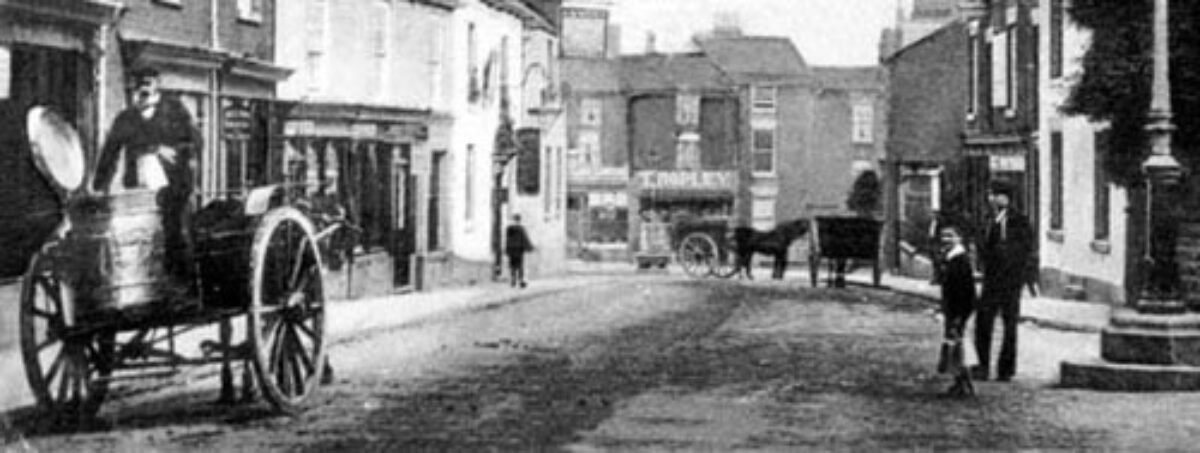The Clegg’s Store was a very impressive department store which stood at the junction of Hawthorn Lane and Church Street in Bank Square. From 1881 to the 1970s it was a major Wilmslow landmark which provided the background to many events from the Carnivals to the annual remembrance parades. Many local people worked and shopped there. This is a short history and thanks to everyone who contributed. If you have any family stories or photographs please contact the Wilmslow Historical Society at wilmslowhistoricalsociety@gmail.com.
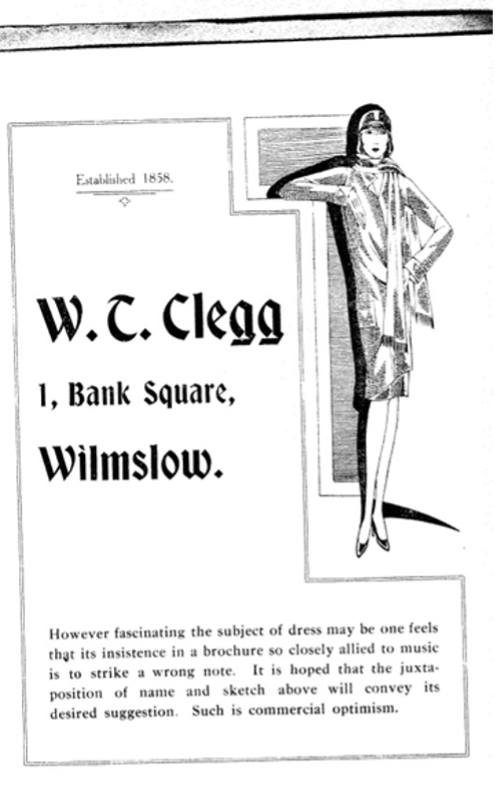
Jon Kelly, December 2022.
The Beginnings
Walter Shields Clegg was born in Oldham around 1848, and no doubt seeing the potential in an expanding and increasingly affluent Wilmslow, opened his store at the corner of Church Street and Hawthorn Lane in January 1881. Clegg specialised as an outfitter and soft furnisher but was prepared to turn his hand to almost anything fashionable and profitable. It was said to be the epitome of business migrating to Wilmslow in the Victorian years……the Shangri-La with its wealthy middle-class spenders. He bought the house next to his store along Hawthorn Lane in order to provide living accommodation for staff and to allow for expansion of the funeral business and the furniture department.
In 1881 a customer could purchase silk at one shilling and eleven pence per yard, (c 9p) and a gentleman could select from a range of shirts with prices up to £3 that were produced in-house by a team of in-house seamstresses and tailors, some of whom lived above the shop with the Clegg family.
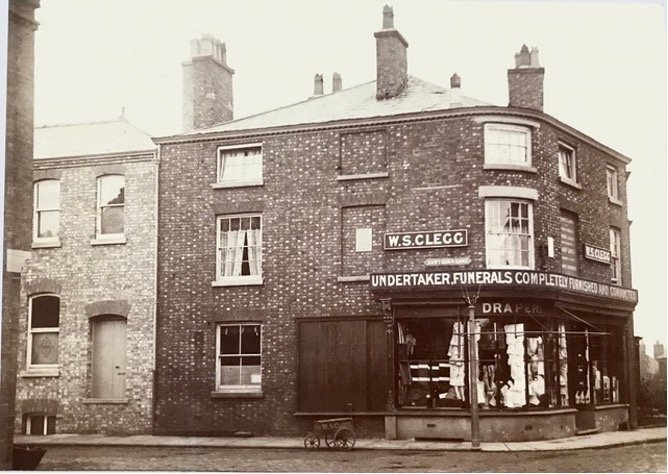
The first store fronting Hawthorn Lane and Church Street in Bank Square. A Clegg’s hand cart for making deliveries has been helpfully parked in front of the shop.
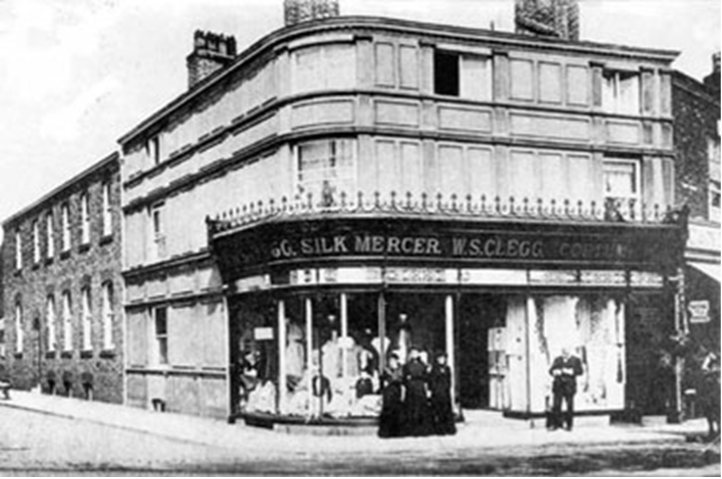
This 1905 picture shows the updated store front and the funeral directors moved down Hawthorn Lane.
Clegg’s was for many years the most celebrated shop in Wilmslow offering fashion, a restaurant and undertakers. By 1910 W S Clegg and his son W T Clegg were also offering after hours and Sunday deliveries for urgent orders.
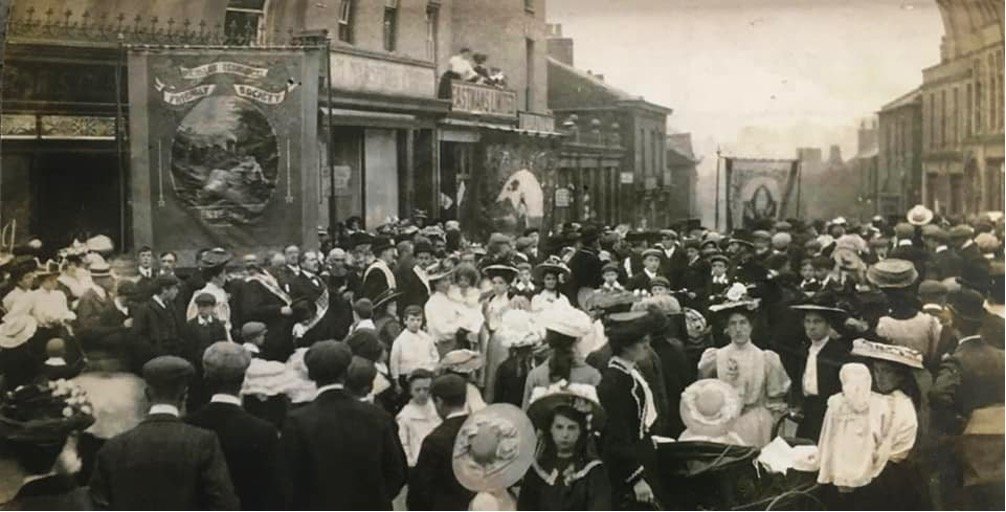
The Wakes Day parade in August 1907 takes place in front of the store. The Emmerson family are clustered around the pram. David Emmerson’s grandfather worked in Clegg’s funeral business in the 1960s and his mother was a seamstress at Clegg’s in the 1960s.
At the annual Wakes holiday in those days all the local friendly societies paraded. The banner in front of the shop reads “Wilmslow Economical Friendly Society”. One of many societies of the type, it started before the 1870s when it was the Wilmslow Economical Sick and Burial Society. In 1894, still under its original name, it had 967 members. For usually a penny a week, a parent could cover the cost of burial of a child or medical bills up to a tight limit. Ray Acton reports that he and his wife were covered with another society till the 1990s. A copy of the Wilmslow Society records from 1912 shows that benefits of £5 were paid after twenty years membership. Indicated amongst the first 7 committee members was a Christopher Bilsborough.
Albert Slack recalls his father was a member when the Society was run by George Broughton who had a hardware shop on Chapel Lane where a fish shop now stands. His father rescued the banner and it was stored in its wooden box at his workshop. When his workshop was rebuilt, Albert took the sizeable banner to the National Trust at Styal, where he hoped it would be preserved.
By the Great War the business was changing, and, although there were still in-house seamstresses, Clegg’s were increasingly sourcing ready-made clothes mass-produced elsewhere. David Tyrell who was born in 1914 and speaking in 1996 said “There was Clegg’s shop. There was one department that was fascinating to see. All the stock – the garments – would be folded in tissue paper. Mr Clegg also organised the funerals, and he was very impressive in his frock coat and black silk hat.”
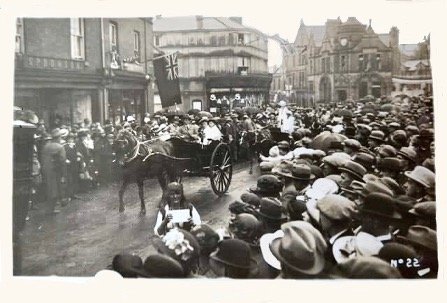
Bowlers, flat caps and homburgs a plenty on a wet day in this picture. But what is the date and occasion? If you know please let the Historical Society know.
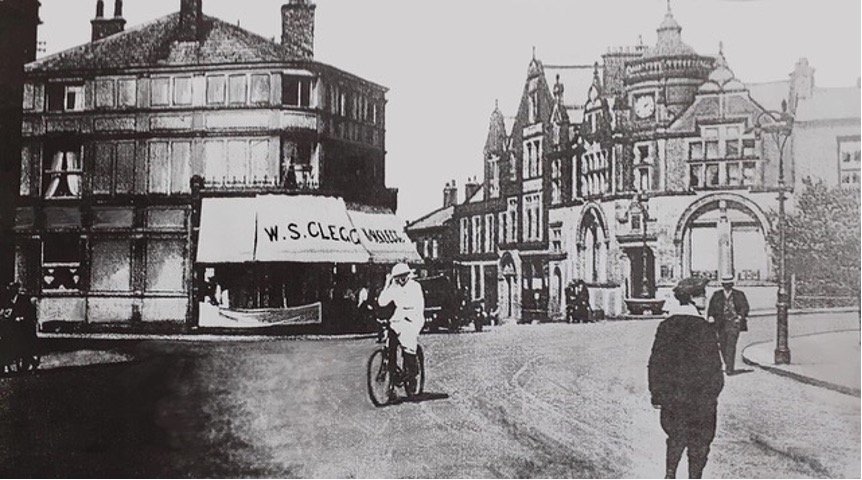
Another picture from 1924 shows the canopy deployed on a finer, hot, sunny, day prior to the major rebuild undertaken in the interwar years.
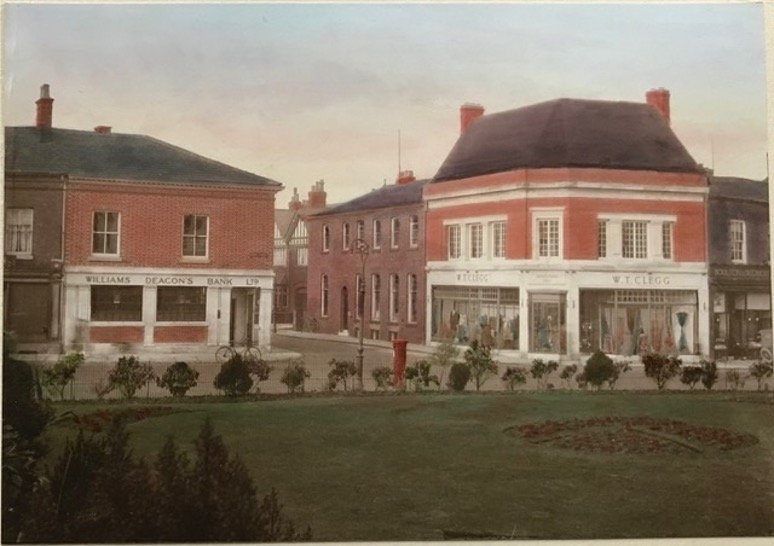
The new building is illustrated in a watercolour of Clegg’s with the Williams and Deacon Bank opposite and a winter view of Sparrow Park Gardens. Along Hawthorn Lane are the black and white gables of the house bought earlier by Mr Clegg.

“However fascinating the subject of dress may be one feels that its insistence in a brochure so closely allied to music is to strike a wrong note. It is hoped that the juxtaposition of name and sketch above will convey its desired suggestion, Such is commercial optimism”
The store had to cope with acquiring the latest fashions. This advert was placed in the Green Room amateur dramatics programme for 1938. The accompanying text is certainly of the period and perhaps a harbinger for the hard times ahead for 1939-1945.
The firm claims to have been established in 1858 which suggests it would have been started by W.T. Clegg, the father of the then ten-year-old Walter Shields Clegg.
World War Two and Post War
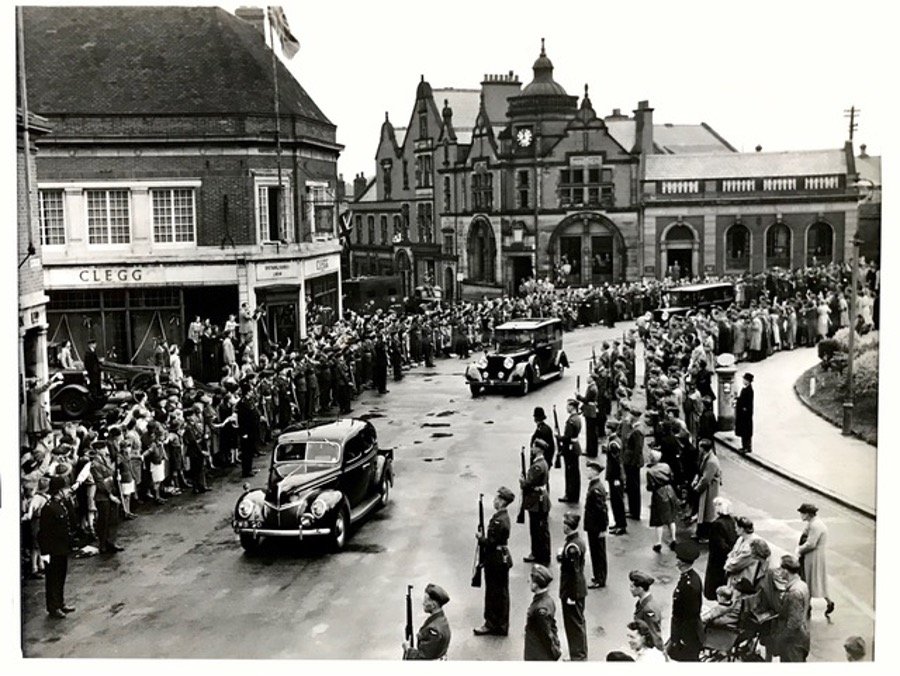
In the forties possibly 1948 King George VI and Queen Elizabeth (later The Queen Mother) passed through Bank Square. The guard of honour look to be from the Royal Air Force with American M1917s rifles built by Remington.
Jacque Bilsborough recalls:
“I lived on Hawthorn Lane behind our flower shop. The King and Queen were travelling through. I went to the end of Kennerlys Lane to see them. The King was on the right rear seat and I got the impression he’d got a bit of make up on. Probably to make him more visible. It wasn’t overdone. They were waving and smiling. Just after the war they were incredibly important for building morale as life was a struggle with food shortages and living accommodation hard to find. They drove up Grove St. (then a two-way road). It was an exciting thing to happen in Wilmslow as it was still a village.”
Ray Acton said
“My mother was a cashier at Clegg’s for over 40 years. The restaurant – one of the few in Wilmslow – had a good reputation which they managed to maintain even in World War 2, when rabbit was served as chicken! It was delightfully conservative….not least in the way employees in the shop addressed each other…..Mr Grimshaw, Mr Wardle, Mrs Dawson, Mrs Roberts etc A kind of serious version of ‘Are You Being Served?’”
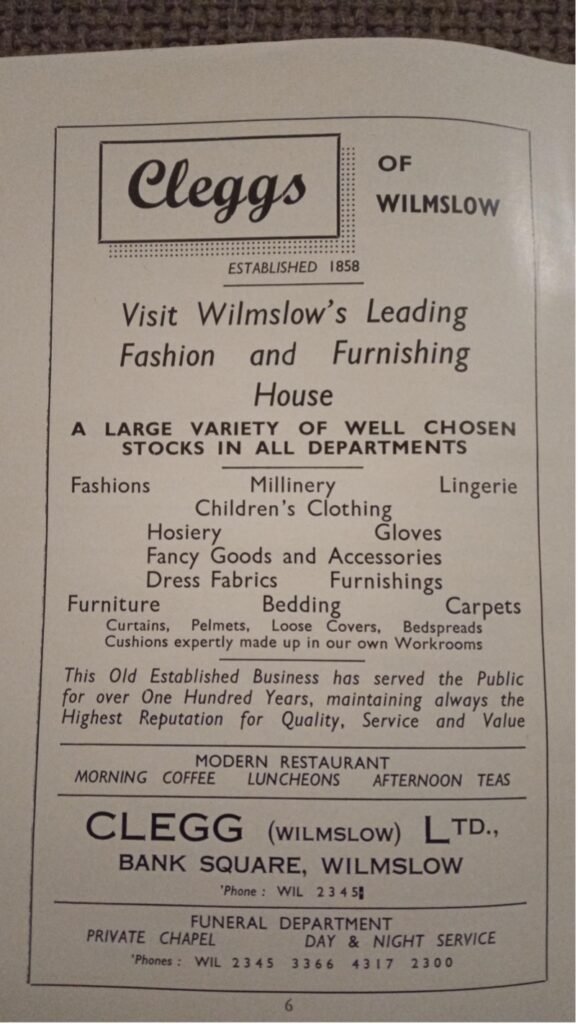
This advert for Clegg’s shows the range of goods available in the mid-fifties. The public café was downstairs which was also where many Wilmslow children were brought to see Santa Claus in his grotto at Christmas.
Jane Oakes remembers
“My mother Ruth Holland was apprenticed as a tailoress with Clegg’s and left at 23 in 1954 when she got married and started a family. I can remember as a toddler going into the store which had wooden floors like the old Affleck and Brown store in Manchester. There were steps downstairs directly opposite the main corner doors where the tailoring took place. My mother would call down there occasionally to catch up with her old colleagues and take me along.
My mother kept in touch with one of the more elderly tailoresses after her retirement when the elderly lady moved to The Hawthorns in the 1950s. She was called Miss Booth and she must have been with Clegg’s all her working life working through both World Wars. Clothes had to fit perfectly and whilst she bought suits from Marjorie Morton on Water Lane, she got my mother to alter them afterwards to fit precisely. Old habits die hard and she was a real stickler for detail!
There was a very popular tea shop, called Watsons, almost opposite on Hawthorn Lane along from the National Westminster Bank I can remember going in when I was little. I can’t remember any others so it must have had good trade. Unlike today when there are so many coffee shops in Wilmslow.”
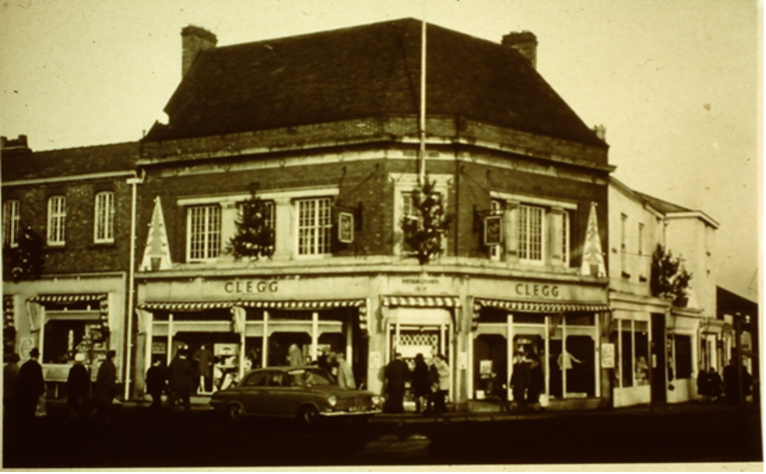
From the car this picture dates from the 1960s. The public café was downstairs which was also where many Wilmslow children were brought to see Santa Claus in his grotto at Christmas.
Angela Hollin writes:
“I remember as a child walking along Hawthorn Lane from the post office and there were grids and you could smell the food being cooked for lunches and the air was hot. I think on the corner there was a revolving door right at the end of Lane and Church Street. Once in the shop you could go to the shoe department going right and down a couple of steps in the Waitrose direction. It wasn’t enormous, I remember being with my Mum and she bought me a lovely pair of red leather shoes! I would think around 1962-4.”
Mike Rhodes worked in the furniture department in the 1960s. He was in a music group with fellow worker Don Rathbone who later was a founder member of the Hollies. Don Rathbone’s father was Gordon, the local stone mason and one time registrar of births, marriages and deaths.
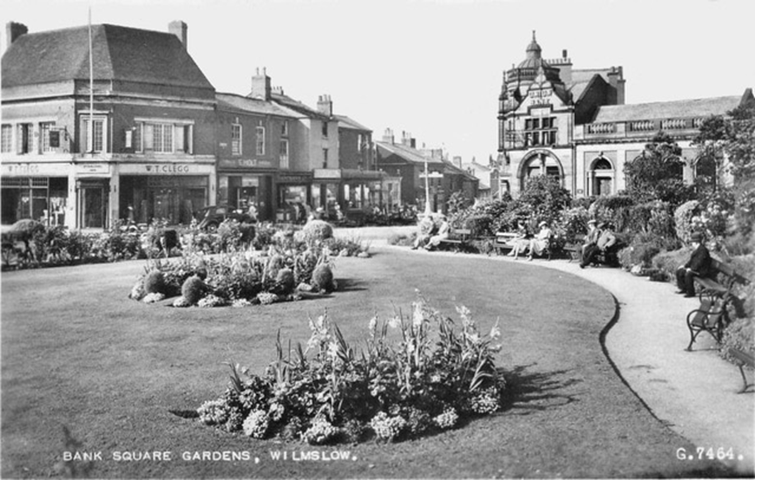
Another view with “Sparrow Park” Bank Square in full bloom on a postcard of the town.
Above, No.2 Bank Square is the building with the round tower. This Edwardian building was the former Midland Bank and later wine bar. No. 4 Bank Square is an inter-war bank building and houses the HSBC bank. Architecturally these are Cheshire East Council “Locally Listed “Assets. (Source: Wilmslow Neighbourhood Plan; Appendix 6 Heritage Assets).
The Funeral Business
Clegg’s funeral business was added in the 1880s and soon had a day-and-night telephone number to Mr Clegg’s his house in Hill Top Avenue off Manchester Road. It might seem strange these days for an outfitter to take on a funeral business but in those days mourning had great significance and required appropriate clothes.
Later his café/restaurant could provide refreshments for mourners and when coffins were required local carpenters would be called upon to make them. The hearse and the funeral limousines would be provided by local taxi firms. Clegg himself was remarked by customers to be “very impressive in his frock coat and black silk hat”.
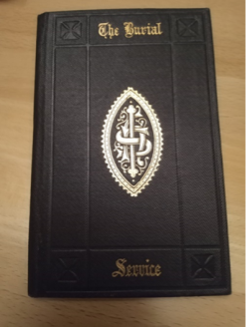
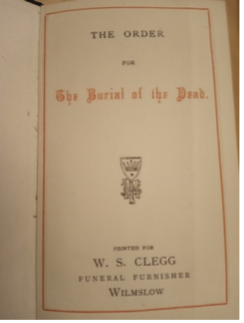
A long-standing funeral director for Clegg’s after the Second World War was Bert Killick and Len Potts was the hearse driver. At the same time, the manager of the furniture business was Len Grimshaw.
Shopping and trading in Wilmslow had changed by the1960s and 1970s and the store was to close. When this finally happened, the other local firm Arthur R Slacks Ltd bought Clegg’s funeral business. Arthur Slack Jnr had written to Clegg’s to buy the business but it had been given to Bert Killick’s successor in lieu of redundancy. However, he could not find premises and continued using the original building.
Eventually an auction was convened but someone commented there was still a body in the chapel! The auction was delayed pending an enquiry. Subsequently, Arthur R Slacks Ltd were offered the business and in the end the “outstanding” funeral did take place as did the auction. The other funeral director emigrated to Canada and the property was sold to a developer.
Albert Slack Jnr recalls that the old pottery mortuary slab was so large and heavy compared with the modern stainless steel equivalents now required by Health and Safety rules that it was donated to a museum in the Liverpool area. But, Slack’s still retain the Victorian/ Edwardian shoulder height trestles from Clegg’s that open into three legs but fold flat with an ingenious hinge mechanism and the six tall candlesticks that would stand round the coffin as someone’s body was laid in rest overnight at a church.
The End
Shopping and trading in Wilmslow had changed by the1960s and 1970s and on 13th March 1975 the following appeared in the London Gazette,
““”Notice is hereby given, pursuant to section 353 (3) of the Companies Act, 1948, that at the expiration of three months from the date of the publication of this notice,the names of the Companies mentioned in the lists hereunder will, unless causeis shown to the contrary, be struck off the Register, and the Companies will bedissolved. This list may include Companies which are being removed from theRegister at their own request ; LIST 3861 Clegg (Wilmslow) Limited.”
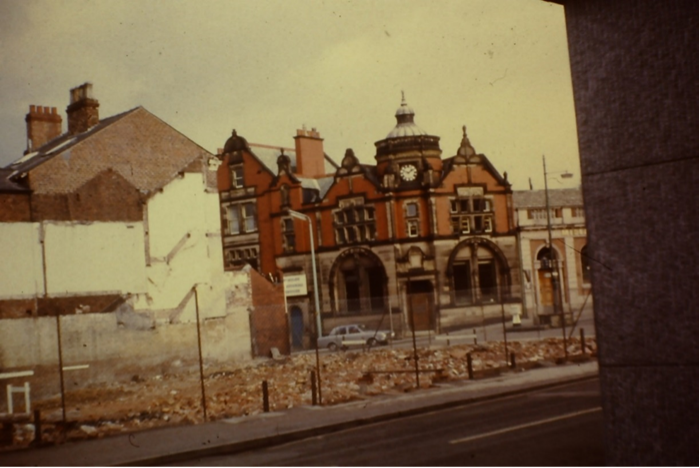
The Clegg’s site after demolition.
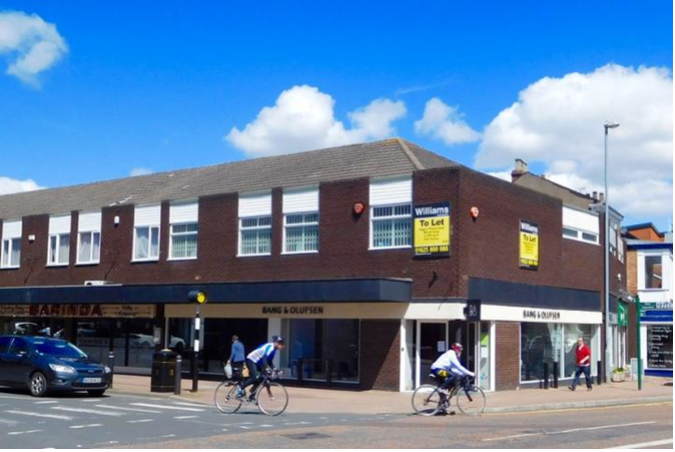
The rather architecturally disappointing building which now stands on the site.
And Finally
Over the years the Clegg’s site and new building has held various outlets including a record shop and Bang and Olufsen who after eight years moved to a new building on Alderley Road.
For many years Ann Rogerson’s mother was the accountant for Clegg’s. When she retired she was presented with the company seal which her daughter Ann kindly presented to Wilmslow Historical Society.
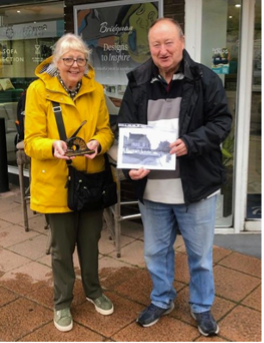
Ann Rogerson is pictured in October 2022 with Cllr Jon Kelly and the company stamp outside Bridgmans shop in which now occupies part of the new building along with the Barinda restaurant and a charity shop.
Kind thanks to Albert Slack, Jane Oakes, Jacque Bilsborough, David Emmerson, Ray Acton, Angela Hollin, Jon Armstrong and David Tyrell for their comments and contributions.
Cllr Jon Kelly January 2023
